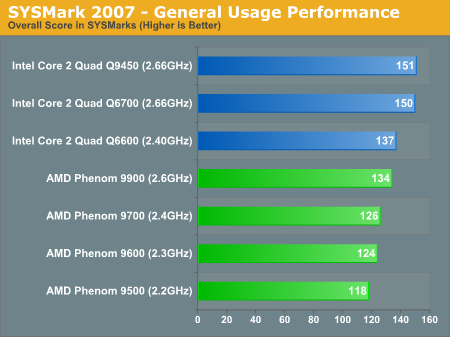AMD's Phenom Unveiled: A Somber Farewell to K8
by Anand Lal Shimpi on November 19, 2007 1:25 AM EST- Posted in
- CPUs
General Application Performance

Right off the bat the numbers aren't looking good for AMD. The Phenom 9600 is priced closest to the Core 2 Quad Q6600, but unfortunately for AMD the Q6600 outperforms it by a healthy 10%. AMD needs a 2.6GHz Phenom to equal the performance of the Q6600, but the 9900 won't be out until next year, when it'll have to face the Penryn based Q9450 and Q9300.
2D Image Manipulation Performance
Once again we broke out the Retouch Artists Photoshop CS3 benchmark, timing a handful of image manipulation operations in CS3:

The Core 2 Quad Q6600 is around 6% faster than the Phenom 9900, 10% faster than the Phenom 9700, and almost 16% faster than the Phenom 9600 which is its closest price competitor throughout the rest of 2007.










124 Comments
View All Comments
leidegre - Monday, November 19, 2007 - link
I'm currently wondering how much of the cache diff between AMD and Intel is performance related, Intel is shipping CPUs with ~12MB cache, AMD today, still ship 2MB/512K, I'm wondering how much of the gap between AMD and Intel is due to cache sizes?Because if you take away this diff what happens then? I strongly believe that AMD has a good architecture once again, but Intel has a superior manufacturing process, and this makes it possible for both higher clock speeds and larger chace levels, and that is one reason why Intel is faster (amoung some things)
Shadowmaster625 - Tuesday, November 20, 2007 - link
intel designs their cache structure around their manufacturing strengths. AMD designs their cache structure around their manufacturing weaknessess. That's what you get with 2 totally different sized companies.sdmock - Monday, November 19, 2007 - link
The difference cache sizes (between Phenom and Penryn) really doesn't make a significant difference in performance. They both have pretty large caches, and increasing the cache will only decrease the misrate by so much. Their caches are so big that most programs probably don't suffer from capacity misses, or misses from limited space in the cache. Making the L2 cache too big would increase the hit time by too much, so I think this is partly why they're using a L3 cache now.I think the main reason Intel makes its cache so big is for marketing purposes. They've got more transistors than they know what to do with so they just put them in the cache. I think AMD was smart to reduce its cache sizes (I think in K8?) from 1MB to 512KB because it probably didn't make a significant performance difference (don't know for sure though) and it saved them money. Of course it's important to remember that each architecture will use the cache differently.
erikejw - Tuesday, November 20, 2007 - link
Cache makes a larger difference for Intel due to not having an internal memory controller hence the large differences in cache sizes.sdmock - Tuesday, November 20, 2007 - link
Intel's Core 2 processors now offer even quicker memory access than AMD's Athlon 64 X2, without resorting to an on-die memory controller.http://www.anandtech.com/cpuchipsets/intel/showdoc...">http://www.anandtech.com/cpuchipsets/intel/showdoc...
Calin - Tuesday, November 20, 2007 - link
There are benchmarks with equal processors (from Intel) differing only in cache size. Usually (in the processors benchmarked, at lower frequencies) the difference is under 10 percent.Maybe in quad cores at higher frequency (2.6 instead of 1.8-2) the difference will be bigger.
fitten - Monday, November 19, 2007 - link
Doesn't matter, unless you intend to buy one of those parts and purposefully disable part of the cache for some reason. You might as well ask "I wonder how much of a gap would be between those parts if a clock cycle was added to the amount of time it took to execute every instruction in the Intel part". The cache is a part of the design (it's just more easily scaled).
I wonder if the Ferarri 365 Daytona would have performed as well if it had only 8 cylinders instead of 12! You gonna buy one and replace the engine in it to find out?
Roy2001 - Monday, November 19, 2007 - link
I still remember AMD's hype. Well, where is the advantage of native quad core? AMD said phenom is 50% faster than Kentsfield, based on simulated data, where is the benchmark?drank12quartsstrohsbeer - Tuesday, November 20, 2007 - link
They probably simulated a bug free phenom :)
soydios - Monday, November 19, 2007 - link
Little bone to pick at the bottom of page 9" "if you're looking at quad-core, chances are that you're doing something else with your system other than game."Future games will use several threads, I'm sure (i.e. Alan Wake). Crysis performance seemed to improve for me when I OC'ed my E6600 to 3.0GHz, holding at a consistent 21-22FPS in the Crysis demo during the more demanding views with my X1900XT. While I'm not exactly running benchmarks under lab conditions, the increase in CPU power did seem to help. IIRC, Crytek has stated that quad cores will be used by Crysis.
Other than that sentence, excellent article, touching on all the major points.
I would like to compliment and say thanks to you for Page 3: First Tunisia, Then Tahoe? The situation and your actions described on that page are a primary reason why you and this site have so much credibility with us, the readers, which is why we come here. Keep it up.